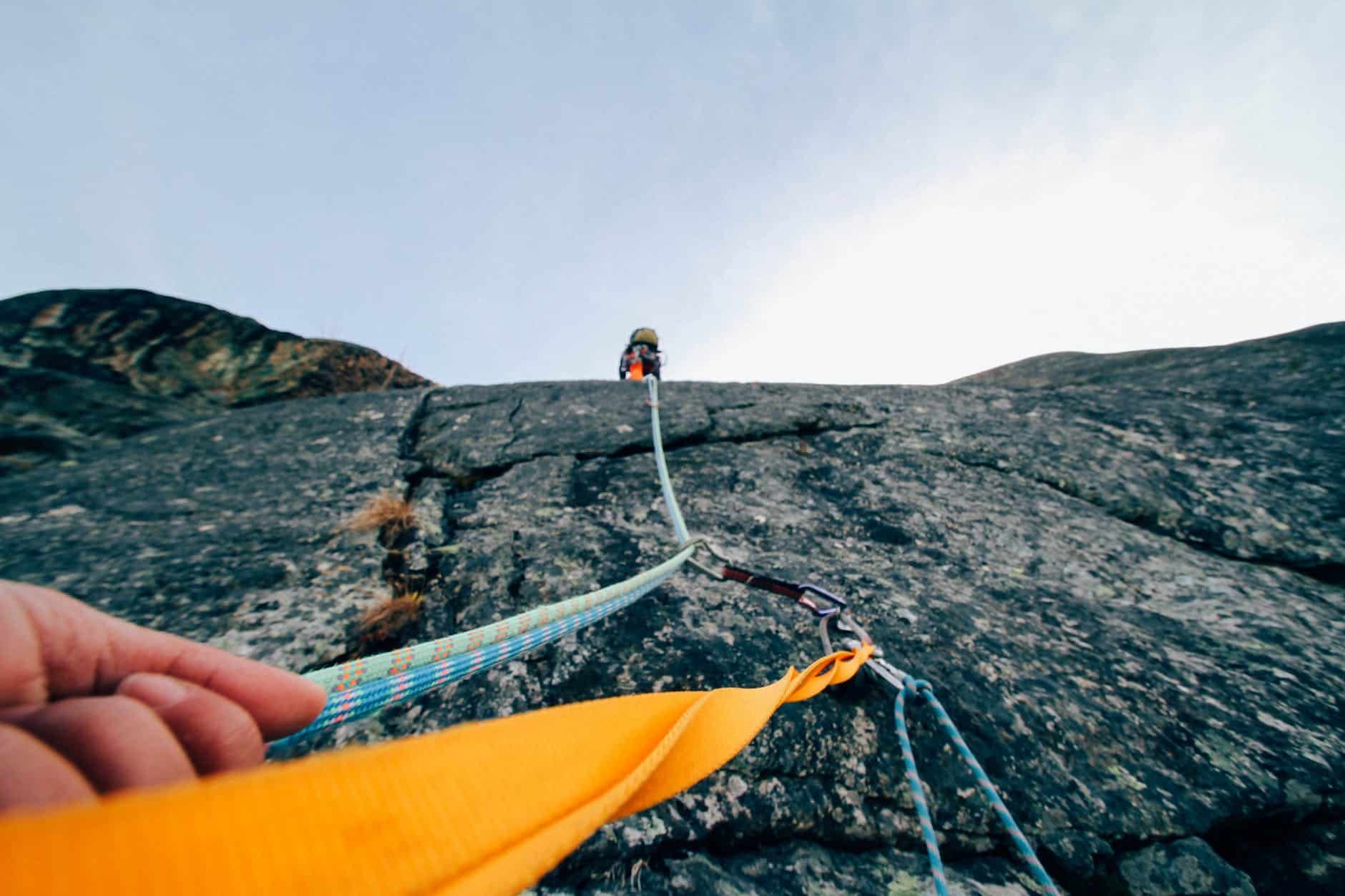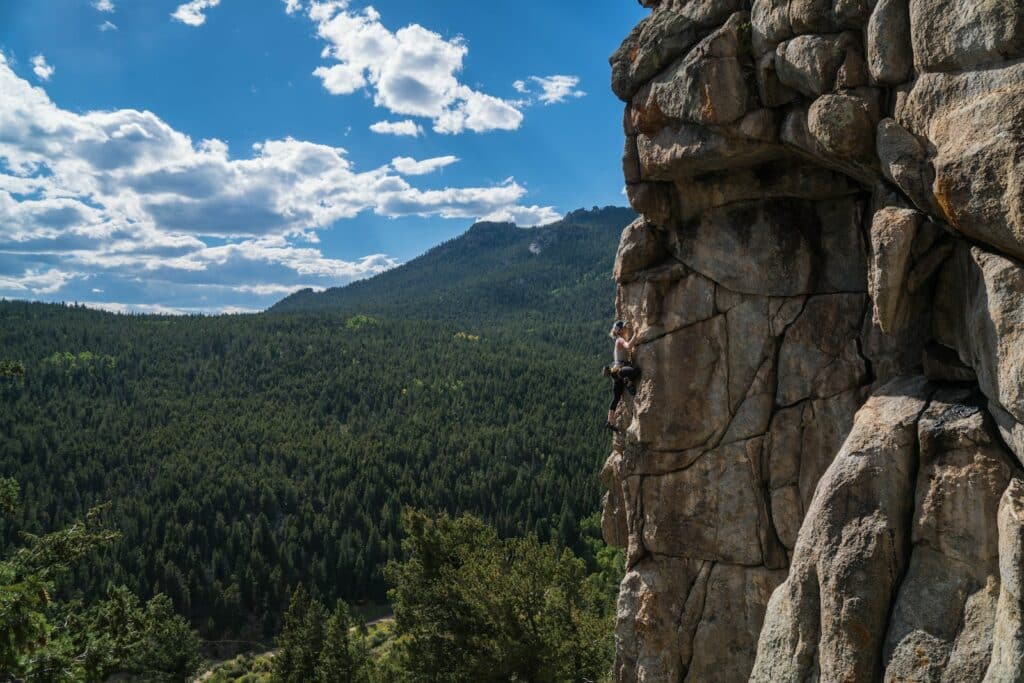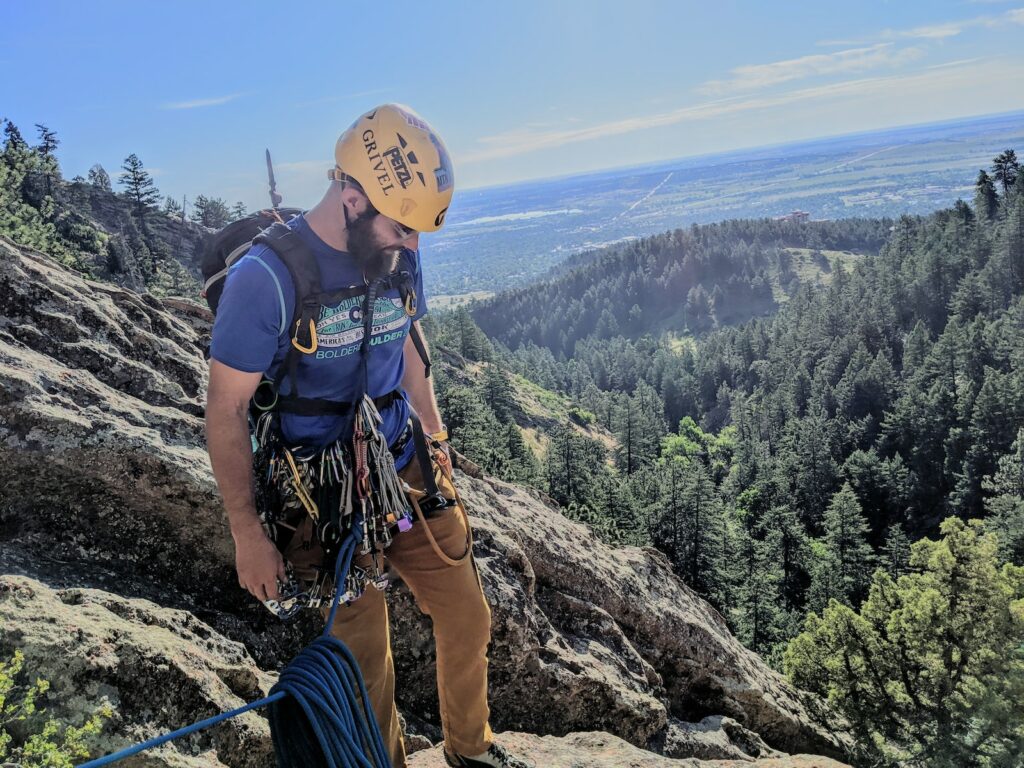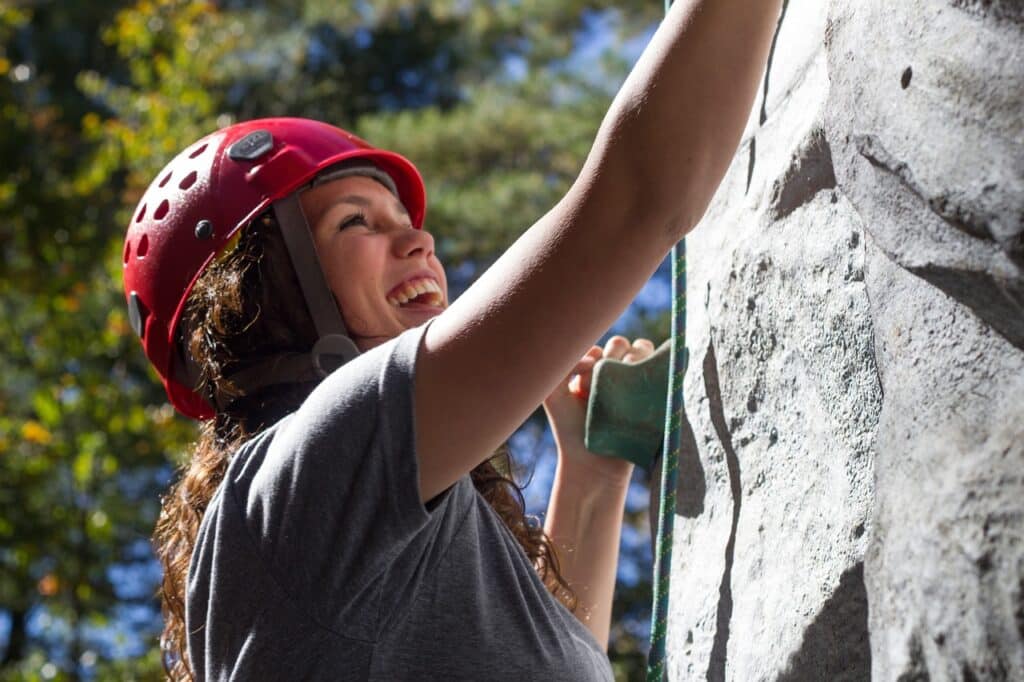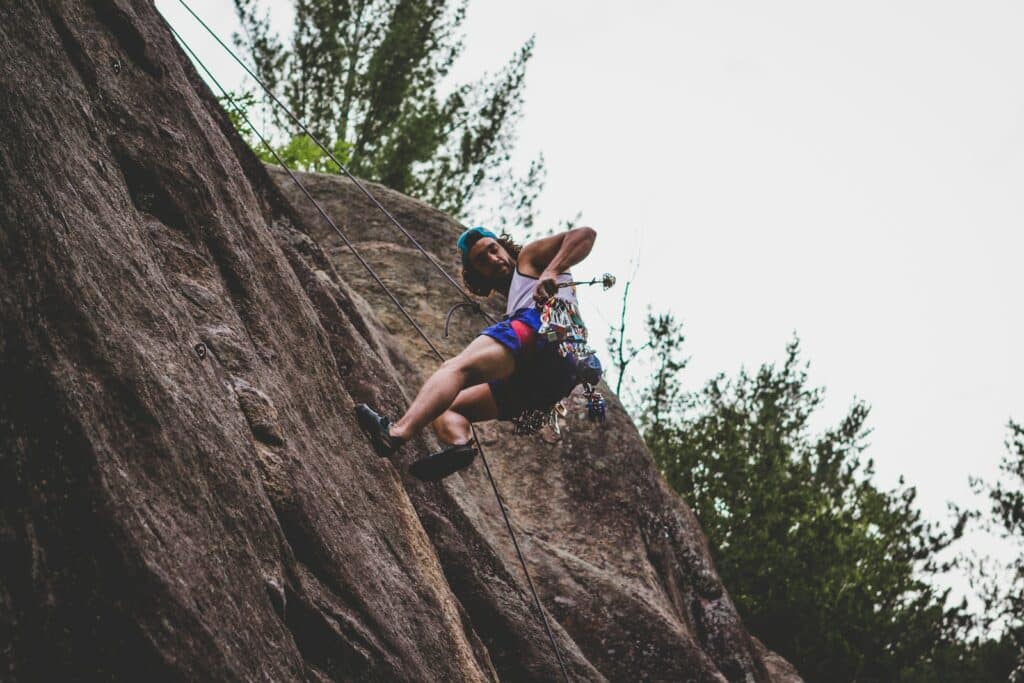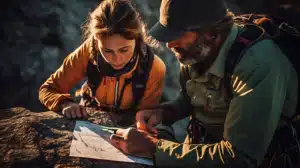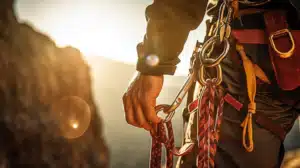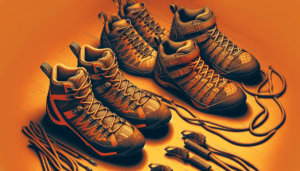Table of Contents
ToggleIntroduction to Trad Climbing
What is Trad Climbing?
Trad climbing, short for traditional climbing, is a form of free climbing in which the lead climber places their own protection equipment as they ascend the route, and the second climber removes this temporary protection as they climb after the lead climber reaches the top (Wikipedia). Unlike sport climbing, where permanent bolts are already in place, trad climbing requires climbers to rely on their own gear placements for protection.
Trad climbing is known for its adventurous and self-reliant nature. It offers climbers the opportunity to explore uncharted routes and climb on natural features, such as cracks and fissures, without relying on pre-installed bolts. This style of climbing demands a combination of technical skills, route-finding ability, and a deep understanding of gear placement techniques.
The History of Trad Climbing
Trad climbing has a rich history dating back to the early days of rock climbing. It was once the dominant form of free climbing, but with the advent of bolted sport climbing and competition climbing in the mid-1980s, its popularity declined (Wikipedia). While sport climbing has since taken the lead in terms of popularity and grade milestones, trad climbing continues to attract climbers who seek a greater sense of adventure, challenge, and connection to the natural environment.
The roots of trad climbing can be traced back to the early 20th century, when climbers began using pitons as temporary protection. Over time, climbers developed a range of gear specifically designed for trad climbing, including nuts, cams, hexes, and slings. These pieces of gear are placed into cracks, pockets, and other features of the rock to create secure anchor points. The development of removable protection revolutionized trad climbing and allowed climbers to protect themselves without causing permanent damage to the rock.
Today, trad climbing remains a popular discipline within the climbing community, attracting climbers of all skill levels who are drawn to the challenge of placing their own protection and exploring new routes. It offers a unique blend of physical and mental engagement, requiring climbers to make calculated decisions about gear placement, route selection, and risk management.
As we delve deeper into the world of trad climbing, we will explore the gear and techniques involved, safety considerations, and popular trad climbing destinations. So let’s gear up and embark on this exciting journey of trad climbing together!
Key Differences: Trad Climbing vs. Top Rope Climbing
When it comes to rock climbing, there are different styles and techniques to explore. Two popular styles are trad climbing and top rope climbing. Understanding the key differences between these styles is essential for climbers looking to expand their skills. Let’s delve into the world of top rope climbing and trad climbing to better grasp their unique characteristics.
Understanding Top Rope Climbing
Top rope climbing is a style of climbing where the rope is anchored at the top of the route, providing a safe and easy way to climb without the need for gear placement. This technique is often recommended for beginners as it allows them to focus on climbing technique without the added challenge of gear placement (Golden Mountain Guides).
One of the main advantages of top rope climbing is its relative safety. The anchor is already in place, providing protection against large falls. This makes it a great option for beginners to practice climbing skills, build confidence, and learn proper climbing techniques (REI). Top rope climbing is generally considered to be a safer style of climbing compared to trad climbing, as the protection is pre-placed and the climber is always connected to a secure anchor point (Climbing.com).
Exploring Trad Climbing
Trad climbing, short for traditional climbing, is a style of climbing that involves placing and removing gear, known as protection, as the climber ascends the route. Unlike top rope climbing, trad climbers rely on their own gear placements to protect against falls. This adds a layer of complexity and challenge to the climbing experience.
Trad climbing is often seen as a more advanced style of climbing, requiring climbers to develop skills in gear placement and route finding. It offers a sense of adventure and exploration as climbers navigate natural features, cracks, and fissures in the rock. Trad climbing allows climbers to experience a greater sense of freedom and self-reliance, as they are responsible for their own protection (REI).
Compared to top rope climbing, trad climbing offers more versatility and the opportunity to tackle routes that may not have pre-placed anchors. It allows climbers to explore a wider range of climbing locations and offers a greater sense of accomplishment when successfully completing a route.
While trad climbing provides a thrilling and rewarding experience, it requires climbers to develop specific skills in gear placement techniques, route finding, and risk management. It is essential to have a solid understanding of the gear needed for trad climbing, including cams, nuts, slings, and anchors (Golden Mountain Guides). Proper training and mentorship are highly recommended for climbers venturing into the world of trad climbing.
Understanding the differences between top rope climbing and trad climbing is crucial for climbers seeking to expand their skills and explore new challenges. Both styles offer unique experiences and opportunities for growth. Whether you choose the safety and simplicity of top rope climbing or the adventure and self-reliance of trad climbing, remember to prioritize safety, develop proper skills, and enjoy the journey of pushing your climbing boundaries.
Gear and Equipment for Trad Climbing
When it comes to trad climbing, having the right gear and equipment is essential for a safe and successful climb. Trad climbing, also known as traditional climbing, involves placing your own gear such as cams, nuts, and hexes into cracks in the rock to protect against falls (REI). Let’s explore the essential gear for trad climbing and the process of placing and removing protection.
Essential Gear for Trad Climbing
Trad climbing requires a specific set of gear to ensure your safety and success on the climb. Here are the essential items you’ll need:
| Gear | Description |
|---|---|
| Climbing Rope | A dynamic climbing rope designed to absorb the energy of a fall. It is typically 60-70 meters long for longer routes. |
| Climbing Harness | A harness that secures around your waist and legs, providing support and attachment points for the rope. |
| Climbing Helmet | A helmet designed to protect your head from falling rocks and potential impacts during a climb. |
| Climbing Shoes | Specialized shoes with sticky rubber soles for better grip and precision on the rock. |
| Cams | A type of protection device that expands and locks into place within a crack in the rock. It offers versatile and secure protection. |
| Nuts | Passive protection devices that are wedged into cracks to provide secure protection. They come in various sizes for different crack widths. |
| Hexes | Hexagonal-shaped protection devices that can be placed in cracks and offer stability and security. They are particularly useful for larger cracks. |
| Slings and Carabiners | Used to extend and connect protection devices to the climbing rope. |
| Belay Device | A device used to control the rope during belaying, which allows for a controlled descent and catch in the event of a fall. |
These are just the basic items needed for trad climbing. Depending on the specific climb and conditions, additional gear such as quickdraws, runners, and anchor-building materials may be required. It’s important to consult a comprehensive trad climbing gear guide for a detailed checklist of the equipment you’ll need.
Placing and Removing Protection
Placing and removing protection is a fundamental skill in trad climbing. It involves strategically selecting and placing gear to protect against potential falls. Here’s a general overview of the process:
- Evaluate the Climb: Assess the route and identify potential placements for protection based on cracks, crevices, and other features on the rock.
- Choose the Right Gear: Select the appropriate cams, nuts, or hexes based on the crack size and shape. Consider the range of sizes you’ll need to cover a variety of crack widths.
- Placement Techniques: Use proper techniques to insert the gear into the crack. For cams, compress the lobes and insert them into the crack, allowing them to expand and lock into place. For nuts and hexes, choose the correct size and carefully wedge them into the crack.
- Test the Placement: Apply gentle pressure to ensure that the gear is secure and solidly placed. Give it a gentle tug to verify its stability.
- Building a Solid Anchor: As you climb higher and place more gear, you’ll need to build a strong anchor system using slings, carabiners, and other materials. This ensures your safety in the event of a fall.
Removing protection follows a similar process in reverse:
- Assess the Situation: Determine which pieces of protection need to be removed based on the climb’s progression.
- Release the Gear: Use gentle pressure and twisting motions to release the cam lobes or carefully tap nuts and hexes to loosen them from the crack.
- Retrieve the Gear: Carefully remove the gear from the crack, ensuring that it doesn’t get stuck or cause any damage to the rock.
- Organize and Store: Store the removed protection on your gear sling or attach it securely to your harness for easy access during future placements.
Mastering the art of placing and removing protection requires practice and experience. It’s crucial to learn from experienced climbers or seek professional guidance to ensure you have the necessary skills and knowledge for safe trad climbing. For more in-depth tips on trad climbing techniques, consult our comprehensive trad climbing techniques guide.
With the right gear and knowledge, you’ll be ready to embark on exciting trad climbing adventures, exploring routes and destinations that require the unique skills and challenges of this traditional style of climbing. Remember to prioritize safety, continuously improve your skills, and enjoy the freedom and adventure that trad climbing offers.
Safety Considerations in Trad Climbing
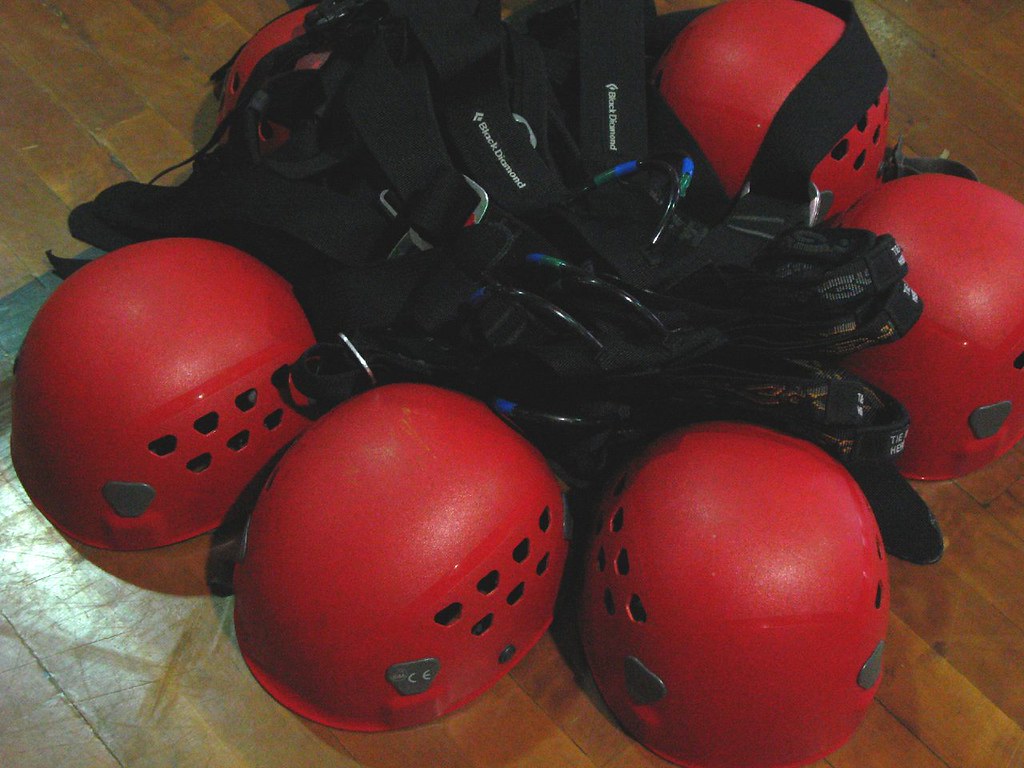
When engaging in trad climbing, safety should always be the top priority. Trad climbing carries a higher level of risk compared to bolted sport climbing, as climbers must rely on their ability to place and remove their own protection equipment (Wikipedia). Here are two important safety considerations to keep in mind when trad climbing: risk management and building strong anchors.
Risk Management in Trad Climbing
Proper risk management is crucial in trad climbing to ensure a safe and enjoyable experience. Here are some key points to consider:
- Assess the route: Before attempting a trad climb, carefully evaluate the difficulty level, the presence of loose rock, and the overall condition of the route. Understanding the potential hazards can help you make informed decisions and minimize risks.
- Skill and experience: Trad climbing requires more advanced skills and knowledge compared to top rope climbing. It’s important to have a solid understanding of gear placement, anchor building, and other trad climbing techniques. Building experience gradually and seeking guidance from experienced climbers can contribute to safer climbing practices.
- Gear inspections: Regularly inspect and maintain your climbing gear, including ropes, harnesses, and protection devices. Ensure that your gear is in good condition and free from any signs of wear or damage. Replace worn or damaged gear promptly.
- Communication and teamwork: Communication is key in trad climbing. Establish clear communication with your climbing partner, discuss climbing strategies, and establish signals for safety-related issues. Climbing with a reliable and experienced partner can enhance safety and provide an extra layer of support.
- Emergency preparedness: Familiarize yourself with basic first aid techniques and carry a well-equipped first aid kit. Additionally, consider bringing a communication device, such as a cell phone or two-way radio, in case of emergencies. Be aware of the nearest emergency services and contact information for the climbing area.
Building Strong Anchors
Anchors are critical in trad climbing as they provide security and protect climbers in the event of a fall. Here are some key considerations when building strong anchors:
- Solid placements: Ensure that gear placements are secure by selecting appropriate cracks, pockets, or other features in the rock. Test each placement by applying a gentle outward force to ensure stability.
- Equalization: Distribute the load evenly among multiple pieces of protection by using proper equalization techniques. This helps to prevent a single piece of gear from bearing the full force in the event of a fall.
- Anchor redundancy: Utilize redundancy in anchor systems by incorporating multiple pieces of protection. If one piece were to fail, the redundancy provides a backup to maintain the integrity of the anchor.
- Anchor material: Select appropriate anchor materials based on the climbing environment and the nature of the rock. Common materials include nuts, cams, slings, and carabiners. Ensure that the materials are in good condition and rated for climbing use.
- Solid placements: Ensure that gear placements are secure by selecting appropriate cracks, pockets, or other features in the rock. Test each placement by applying a gentle outward force to ensure stability.
- Load distribution: When building an anchor, consider the direction of potential forces and aim for a balanced distribution of loads. This helps to prevent excessive stress on a single piece of gear and ensures the anchor’s overall strength.
- Anchor evaluation: Regularly inspect and evaluate your anchor system throughout the climb. Look for signs of wear, movement, or shifting. Be prepared to make adjustments or rebuild the anchor if necessary.
By incorporating these safety considerations into your trad climbing practices, you can minimize risks and enjoy a rewarding climbing experience. Remember to always stay updated on the latest safety practices and seek guidance from experienced climbers. Stay safe, be prepared, and have fun exploring the vertical world of trad climbing!
Developing Skills for Trad Climbing
To become proficient in trad climbing, it’s essential to develop specific skills that are unique to this style of climbing. Two important skills to focus on are learning gear placement techniques and honing your route finding and navigation abilities.
Learning Gear Placement Techniques
One of the fundamental skills in trad climbing is the ability to place gear effectively to protect yourself during the climb. Trad climbing requires climbers to have a solid understanding of how to place gear and build anchors to ensure their safety (Climbing.com).
There are various types of gear used in trad climbing, including cams, nuts, hexes, and other specialized protection devices. Learning how to select the appropriate gear for different cracks, pockets, or other features of the rock is crucial.
As a trad climber, you’ll need to understand the principles of passive and active gear placement. Passive gear, such as nuts and hexes, relies on the natural shape of the rock for stability, while active gear, such as cams, expands and locks into place. Properly placing these pieces of protection requires practice and experience.
To develop your gear placement skills, consider taking a trad climbing course or learning from experienced climbers. Practice on easy climbs or in controlled environments before attempting more challenging routes. As you gain experience, you’ll become more adept at assessing the rock and selecting the right gear for each placement.
Route Finding and Navigation
Trad climbing often takes place in natural settings, where climbers must navigate their way up the rock face without the aid of pre-placed bolts. Route finding and navigation are essential skills to ensure a safe and successful climb.
When trad climbing, you’ll need to identify the best line to follow, considering factors such as the difficulty of the climb, the availability of gear placements, and the overall safety of the route. This involves studying guidebooks, route descriptions, and maps to familiarize yourself with the area.
During the climb, you’ll need to make decisions on the go, identifying the most feasible path and adjusting your route if necessary. Being able to assess the rock for potential gear placements and spotting natural features that can assist in your ascent is crucial.
Improving your route finding and navigation skills requires experience and exposure to different climbing areas. Start with well-documented routes in well-traveled areas and gradually progress to more remote or less-documented climbs. Climbing with experienced partners can also enhance your skills as you learn from their knowledge and decision-making process.
By continuously practicing and refining your gear placement techniques and route finding skills, you’ll become a more confident and proficient trad climber. Remember to always prioritize safety, seek guidance from experienced climbers, and gradually push your limits as you gain experience and expertise.
For more information on trad climbing techniques, gear, safety, and other tips, check out our articles on trad climbing and trad climbing tips.
Popular Trad Climbing Destinations
If you’re looking to embark on a trad climbing adventure, there are several incredible destinations around the world that offer a wide range of routes for climbers of all skill levels. Here are five popular trad climbing destinations that should be on your radar:
Joshua Tree National Park, California
Located in California, Joshua Tree National Park is renowned for its unique rock formations and diverse trad climbing opportunities. The park offers a variety of challenging routes for all skill levels, from beginner to advanced. Climbers at Joshua Tree can expect to encounter granite, monzogranite, and quartz monzonite formations, providing a thrilling and unforgettable climbing experience. With its stunning desert landscape and the iconic Joshua Trees, this national park offers a one-of-a-kind trad climbing adventure.
Yosemite National Park, California
Yosemite National Park is a mecca for rock climbers from around the world, and it’s not hard to see why. The park’s granite walls are legendary, offering some of the most classic and challenging trad climbing routes on the planet. Climbers flock to Yosemite to tackle iconic formations like El Capitan and Half Dome. With its breathtaking scenery and a rich history of climbing, Yosemite is a must-visit destination for any trad climber seeking an unforgettable experience.
The Gunks, New York
For East Coast climbers, the Shawangunk Ridge, or “The Gunks,” is an iconic trad climbing destination. Located just a short drive from New York City, this area is known for its steep and technical routes that require good technique and gear placement skills. Climbers at The Gunks can expect to find high-quality quartz conglomerate rock, offering a unique and challenging climbing experience in a beautiful natural setting.
Red River Gorge, Kentucky
Nestled in the heart of Kentucky, the Red River Gorge is a world-class trad climbing destination. This sandstone wonderland boasts a wide range of routes suitable for climbers of all abilities. Whether you’re a beginner or an experienced climber, you’ll find plenty of options to test your skills and enjoy the stunning beauty of the area. The Red River Gorge is known for its unique rock formations, including towering cliffs, scenic overhangs, and challenging cracks.
Seneca Rocks, West Virginia
Steeped in climbing history, Seneca Rocks in West Virginia is a must-visit trad climbing destination. With routes dating back to the 1930s, this iconic area offers exposed and technical face climbs that will challenge even the most experienced climbers. The quartzite rock formations at Seneca Rocks provide a wide range of climbing opportunities, from moderate routes to more demanding challenges. The stunning views from the summit make every climb at Seneca Rocks a truly memorable experience.
These are just a few of the many incredible trad climbing destinations around the world. Each of these locations offers its own unique challenges and rewards, making them popular choices for climbers of all levels. Whether you’re a beginner looking to hone your skills or an experienced climber seeking new adventures, these destinations provide the perfect playground for trad climbing enthusiasts. So grab your gear and get ready to explore these remarkable trad climbing spots.
Trad Climbing vs. Sport Climbing
When it comes to rock climbing, there are various styles and techniques to explore. Two popular styles are trad climbing and sport climbing. Understanding the differences between these styles is essential for climbers looking to delve into the world of trad climbing.
Understanding Sport Climbing
Sport climbing is a style of climbing that focuses on the physical ascent of a preplanned route with preplaced bolts. These bolts act as anchors for the climber’s protection, allowing them to clip their rope into the bolts as they ascend. Sport climbing can be enjoyed both outdoors on natural rock faces and indoors at climbing gyms.
One of the main advantages of sport climbing is the convenience of having preplaced bolts. This allows climbers to focus on their technique and physical performance without the added responsibility of placing their own protection. Sport climbers can progress quickly through routes, attempting challenging moves and pushing their limits.
Comparing Trad Climbing and Sport Climbing
Trad climbing, short for traditional climbing, is the older style of climbing that predates sport climbing. In trad climbing, climbers are responsible for placing their own protection as they ascend. This involves using various gear such as chocks and camming devices to secure themselves to the rock. The strategic placement of this gear along the climbing route is crucial for safety.
One of the key differences between trad climbing and sport climbing is the level of mental preparation and technical climbing skills required. Trad climbers must possess a deep understanding of gear placement techniques, route finding, and navigation. Unlike sport climbing, trad climbers have the freedom to plan their own route, relying on their knowledge and equipment to create secure anchors.
Trad climbing is typically done outdoors on mountainsides or rock faces. The natural environment adds an element of adventure and exploration to the climbing experience. It requires climbers to adapt to the varying terrain and challenges presented by each route.
In terms of safety, sport climbing is generally considered safer than trad climbing due to the preplaced bolts that can be checked for safety. However, the safety of trad climbing ultimately depends on the competence and skill of the climber in creating secure anchors. Proper training, knowledge of gear placement, and anchor building techniques are crucial for maintaining safety in trad climbing.
To summarize, here are some key differences between trad climbing and sport climbing:
| Trad Climbing | Sport Climbing |
|---|---|
| Requires the placement of personal protection | Relies on preplaced bolts for protection |
| Involves planning a route and securing oneself using gear | Follows a preplanned route with preplaced bolts |
| Primarily done outdoors on natural rock faces | Can be done both outdoors and indoors in climbing gyms |
| Requires knowledge of gear placement techniques | Focuses on physical performance and technique |
| Safety is dependent on the competence of the climber in creating secure anchors | Safety is facilitated by preplaced bolts that can be checked |
Both trad climbing and sport climbing offer unique experiences and challenges. Choosing between the two styles depends on personal preference, skill level, and the desire for adventure and self-reliance. Regardless of the chosen style, climbers should always prioritize safety and continually enhance their skills through proper training and practice

